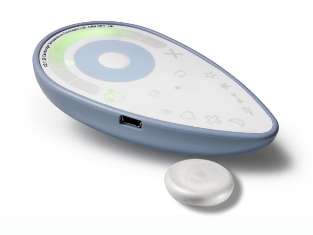Revolutionary fertility monitor helps couples conceive without IVF
14 October 2009
DuoFertility is a groundbreaking new fertility monitor developed by Cambridge University spin-out Cambridge Temperature Concepts Ltd, which helps women to maximise their chances of conceiving naturally without resorting to fertility treatment.
One in six women in the UK have difficulties conceiving — and is predicted to rise to one in three by 2020. Many women turn to costly, invasive fertility treatments such as IVF, which typically has a success rate of 20%.

The DuoFertility reader and sensor
DuoFertility has a revolutionary way of measuring body basal temperature (BBT) to detect ovulation. BBT is the lowest temperature attained by the body during rest and increases by approximately 0.3°C during ovulation; if accurately detected, this can help to identify the most fertile days of a woman’s cycle, allowing her to plan intercourse to maximise her chances of conceiving.
However, BBT is not generally considered to be a reliable indicator of ovulation due to the requirement for users to take manual temperature measurements.
DuoFertility has solved this problem by automatically measuring a woman’s temperature 20,000 times every 24 hours, allowing it to predict fertile days up to 6 days in advance. It also allows users to enter general fertility clues, input to advanced algorithms that predict the optimum time to try to conceive up to 6 days in advance.
In addition, a number of other general fertility clues and health symptoms, such as ovulation pain, cervical mucus quality and illness, can be manually input into the monitor to aid the analysis and improve the prediction.
DuoFertility has developed advanced, proprietary algorithms that analyse all the input to predict the optimum time to try and conceive up to 6 days in advance. DuoFertility is currently the only fertility monitor on the market to incorporate these factors into its analysis, making it the solution of choice for couples that want to put all the chances of achieving pregnancy on their side.
Dr D Naumann, GP in Paderborn, Germany explained, “One of the traditional methods for ovulation monitoring is the measurement of BBT. However, because of the way it was measured in the past, it was not considered reliable by some experts. It required the woman to wake up early at the same time everyday to make a measurement with a thermometer and so it often caused them stress, worry and loss of sleep which was not favourable to achieving pregnancy. Ideally one needs a continuous measurement of temperature throughout the night to determine BBT.”
Dr Oriane Chausiaux, DuoFertility’s Chief Scientific Officer, added that, “The very actions of waking up to take the reading could change the body temperature. Additionally, as traditional oral BBT measurement provided a single data point per day, it was often difficult for the user to identify the temperature change until 2 or 3 days after ovulation — by which point the fertility window of opportunity was over.
"It took considerable discipline to take the temperature correctly every day without fail — miss a day and you could miss the first data point for ovulation altogether. All these factors, combined with the need for the couple to graph the data manually and interpret the data themselves left too much room for error and consequently, in the UK, BBT was not the preferred ovulation monitoring method.”
However, the fundamental science behind BBT as an indicator of ovulation is well established. The ruptured follicle? left behind after the release of the egg? forms the corpus luteum?, which secretes progesterone? that causes a rise in BBT of as little as 0.3°C. The challenge is to find a way to accurately detect this change, or biphasic? pattern, on an automatic basis, isolating it from the normal body temperature changes that can go up or down by a couple of degrees during a day – solving this challenge is exactly what DuoFertility does.
DuoFertility consists of two parts — the sensor and the display unit. The coin-sized sensor is discreetly attached under the arm using an adhesive patch, where it can be worn continuously and removed and replaced as required.
Patented technology enables it to measure a woman’s temperature to within hundredths of a degree, enabling changes in BBT to be accurately determined. This non-intrusive, fully automatic system collects more than 20,000 temperature measurements during each 24 hour period and processes this data for analysis.
The sensor is wirelessly linked to the small, hand-held display unit which is roughly the size of a computer mouse. This further analyses the data from the sensor displays fertile days up to six days in advance. This prediction enables couples to plan ahead for when to try for a baby.
“Having a few days notice to plan for a romantic evening, according to our users’ feedback, removes a huge amount of stress and can make a significant improvement to the chances of becoming pregnant,” said Dr Shamus Husheer, the inventor of DuoFertility and CEO of the company behind it, Cambridge Temperature Concepts Ltd.
“All data can be displayed on a computer for examination in greater detail by the user or her doctor. DuoFertility also goes a step further - under strict confidentiality, each entry is sent to DuoFertility’s server to contribute as input to the DuoFertility algorithms. The algorithms learn and improve the accuracy of the prediction as more data is collected and also draw on patterns and data from other women in the company’s database for further optimisation,” added Dr Husheer.
“Our sophisticated software also flags up when someone has unusual results so that our fertility experts can analyse the data and contact the user with advice. We establish very close relationships with our users to assist them with the challenge of becoming pregnant and users really appreciate having our expert help and advice.”
Bookmark this page